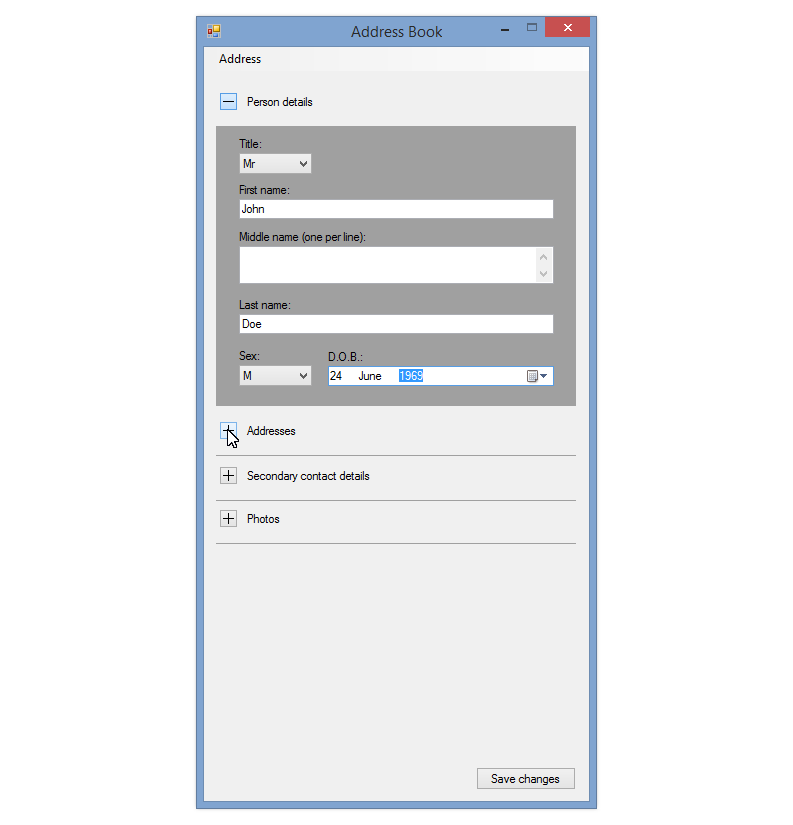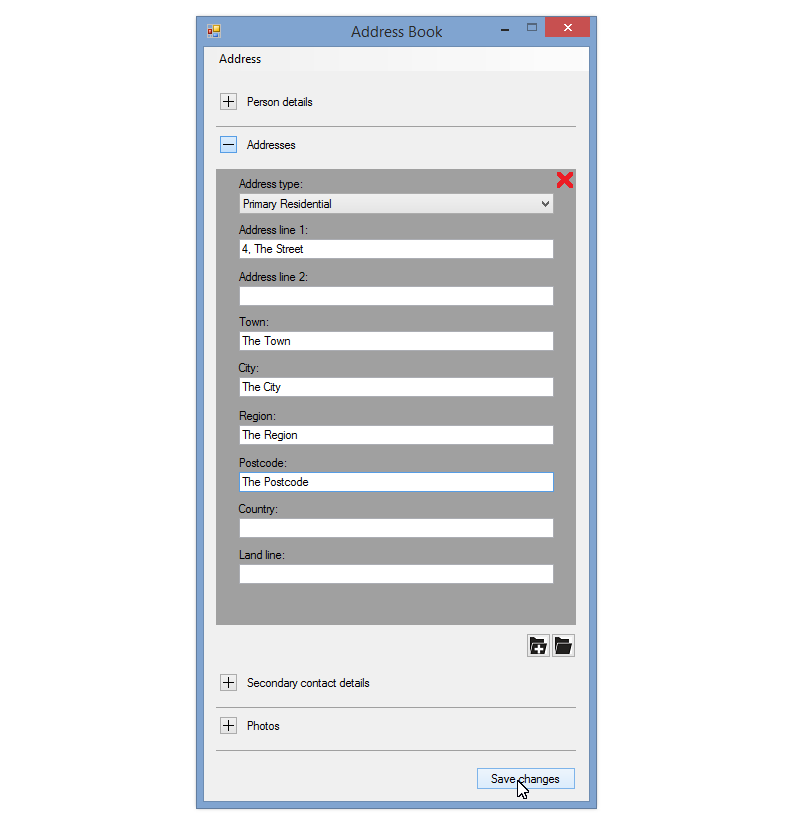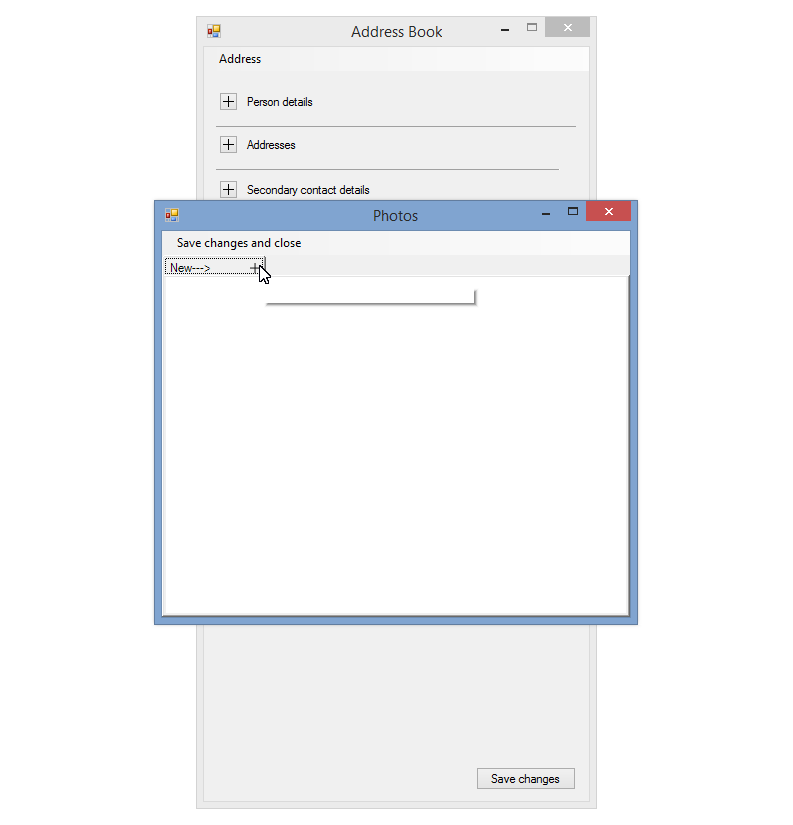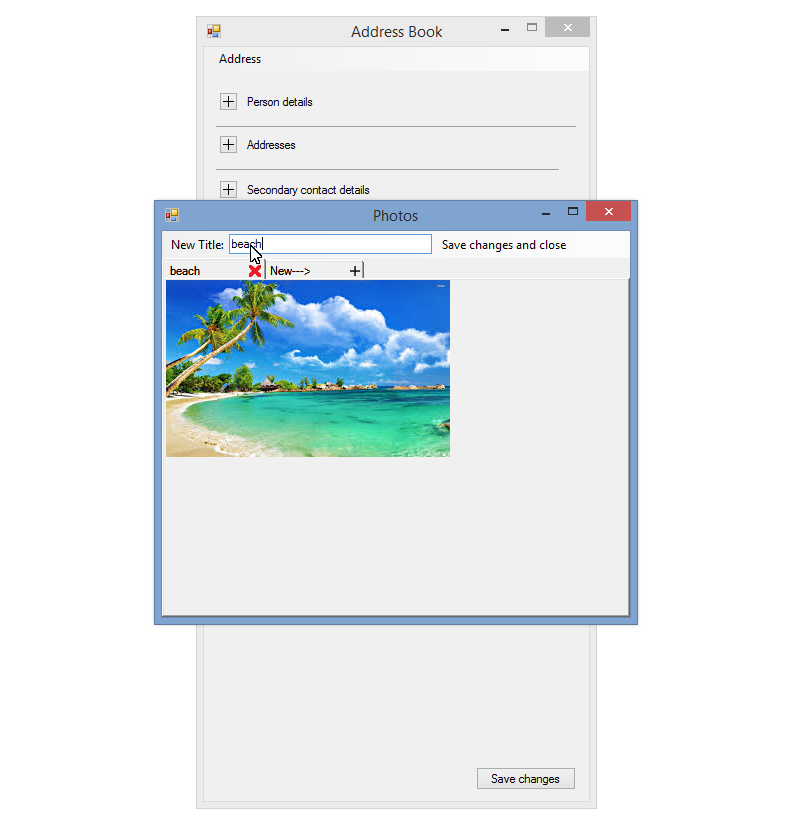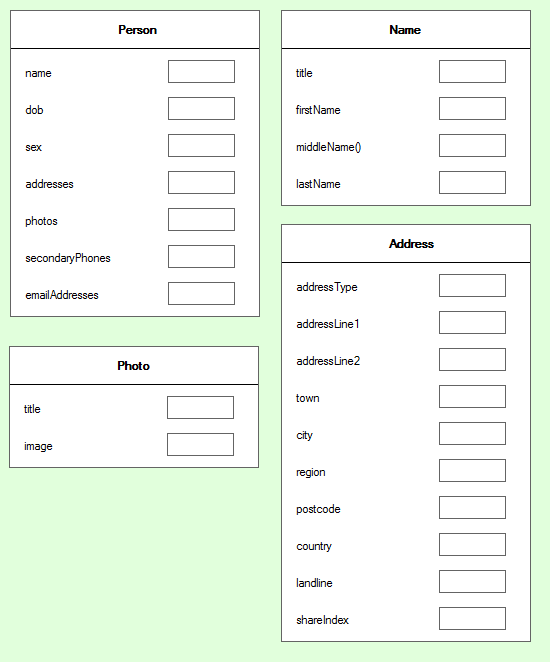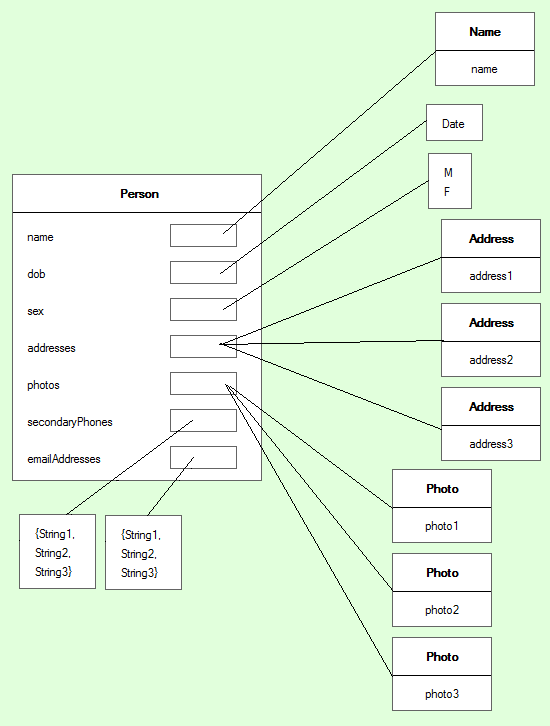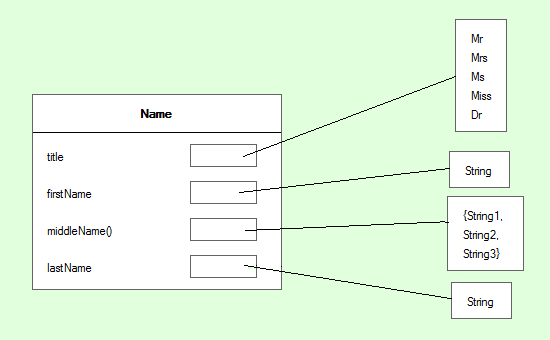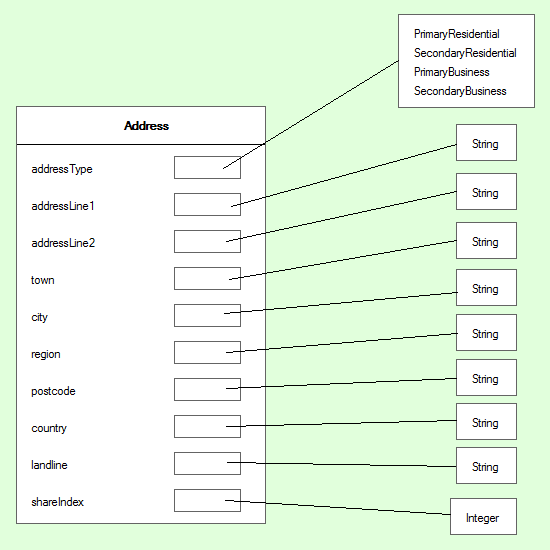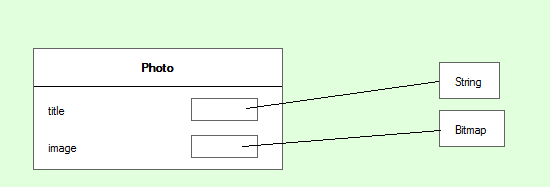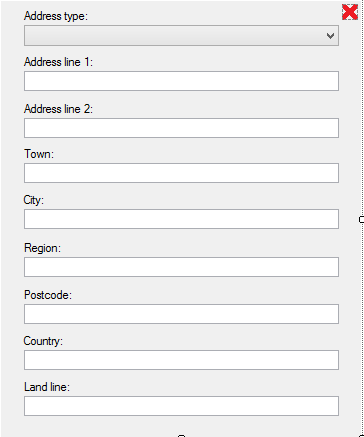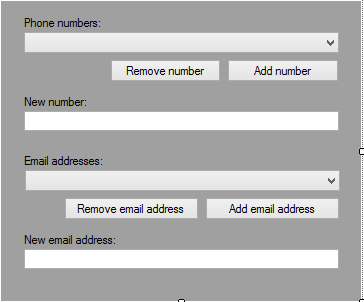VB.Net: OOP Address Book
Overview
This is a fully functional binary OOP Address Book which allows entry and retrieval of names, addresses (with shared address linking), birth dates, phone numbers, email addresses, photos, etc. All of this information is contained either in the Person class, or its component members.
Figure 1.0 Entering data
Figure 1.1 Saving data
Figure 1.2 Adding photos
Figure 1.3 Changing photo titles
The Address Book consists of a system core of objects coordinated by a coordinating class. The objects are, one composite class
- Person (see figure 2.1)
All of the other objects are component members of the Person class, either as a single instance attribute, such as the Name class, or multiple instance objects, such as the Address and Photo classes:
- Name (see figure 2.2)
- Address (see figure 2.3)
- Photo (see figure 2.4)
The Core Classes
Figure 2.0 Classes
Figure 2.1 The Person class
Figure 2.2 The Name class
Figure 2.3 The Address class
Figure 2.4 The Photo class
The GUI
The GUI is quite complex, consisting of six forms, all of which are dialog forms, with the exception of the main form, frmMain which remains open for the duration of program usage.
There are also five usercontrols, used mainly for data input, but these range from a simple extended panel with the only purpose of setting DoubleBuffered, to a simple UserControl hosted in a menustrip, used for editing a TabPage's Text, with the remaining three Controls used for data input.
It was challenging to keep the Form sizes to a minimum and also provide an intuitive user interface which provides means to enter and browse addresses and names, birthdays etc., making data entry as easy as possible by providing address suggestions based on a user entered search term. The Address Book is fully searchable, by:
- FirstName Startswith
- LastName Startswith
- Business Name
- Town
- City
- Region
- PostCode
- Landline
It also provides a search facility for searching for Person objects where the birthday falls within the current week.
The Details Control
Public Class detailsControl
Private Sub ComboBox1_SelectedIndexChanged(ByVal sender As System.Object, ByVal e As System.EventArgs) Handles ComboBox1.SelectedIndexChanged
Select Case ComboBox1.SelectedIndex
Case 0
ComboBox2.SelectedIndex = 0
Case 1, 2, 3
ComboBox2.SelectedIndex = 1
Case Else
ComboBox2.SelectedIndex = -1
End Select
End Sub
Public Sub setDetails(ByVal p As Person)
ComboBox1.SelectedIndex = p.name.title
TextBox1.Text = p.name.firstName
TextBox2.Lines = p.name.middleName
TextBox3.Text = p.name.lastName
ComboBox2.SelectedIndex = p.Sex
DateTimePicker1.Value = p.dob
End Sub
Public Function getName() As Name
Dim m As New List(Of String)(TextBox2.Lines)
m.RemoveAll(Function(s) s.Trim = "")
Return New Name(DirectCast(ComboBox1.SelectedIndex, Name.personTitle), TextBox1.Text, m.ToArray, TextBox3.Text)
End Function
Public Function getSex() As Person.PersonSex
Return DirectCast(ComboBox2.SelectedIndex, Person.PersonSex)
End Function
Public Function getDOB() As Date
Return DateTimePicker1.Value.Date
End Function
End Class
The addressControl
Public Class addressControl
Private use As usage
Public Enum usage
Display
Edit
End Enum
Private shareIndex As Integer = 0
Public Sub New(ByVal use As usage, ByVal a As Address)
InitializeComponent()
If use = usage.Display Then
PictureBox1.Visible = False
Dim types() As Object = New Object() {Address.AType.PrimaryResidential, Address.AType.SecondaryResidential, Address.AType.PrimaryBusiness, Address.AType.SecondaryBusiness}
ComboBox1.SelectedIndex = Array.IndexOf(types, a.addressType)
ComboBox1.Enabled = False
TextBox1.Text = a.addressLine1
TextBox1.ReadOnly = True
TextBox2.Text = a.addressLine2
TextBox2.ReadOnly = True
TextBox3.Text = a.town
TextBox3.ReadOnly = True
TextBox4.Text = a.city
TextBox4.ReadOnly = True
TextBox5.Text = a.region
TextBox5.ReadOnly = True
TextBox6.Text = a.postcode
TextBox6.ReadOnly = True
TextBox7.Text = a.country
TextBox7.ReadOnly = True
TextBox8.Text = a.landline
TextBox8.ReadOnly = True
Else
If a IsNot Nothing Then
Dim types() As Object = New Object() {Address.AType.PrimaryResidential, Address.AType.SecondaryResidential, Address.AType.PrimaryBusiness, Address.AType.SecondaryBusiness}
ComboBox1.SelectedIndex = Array.IndexOf(types, a.addressType)
TextBox1.Text = a.addressLine1
TextBox2.Text = a.addressLine2
TextBox3.Text = a.town
TextBox4.Text = a.city
TextBox5.Text = a.region
TextBox6.Text = a.postcode
TextBox7.Text = a.country
TextBox8.Text = a.landline
shareIndex = a.shareIndex
End If
End If
End Sub
Private Sub PictureBox1_Click(ByVal sender As System.Object, ByVal e As System.EventArgs) Handles PictureBox1.Click
Dim nl As String = Environment.NewLine
Dim response As MsgBoxResult
response = MsgBox("Delete this address?" & nl & nl & _
"Click OK to delete." & nl & _
"Click Cancel to keep.", _
MsgBoxStyle.OkCancel Or MsgBoxStyle.DefaultButton1 Or MsgBoxStyle.Question)
If response = MsgBoxResult.Ok Then
Dim x As Integer = Me.Left
Me.Dispose()
''needs removing from collection
For Each c As addressControl In frmMain.Panel5.Controls.OfType(Of addressControl)()
If c.Left > x Then
c.Left -= 360
End If
Next
End If
End Sub
Public Function getAddress() As Address
Dim a As Address = New Address(DirectCast([Enum].Parse(GetType(Address.AType), ComboBox1.Text.Replace(" ", "")), Address.AType), _
TextBox1.Text, TextBox2.Text, TextBox3.Text, TextBox4.Text, _
TextBox5.Text, TextBox6.Text, TextBox7.Text, TextBox8.Text)
If shareIndex > 0 Then a.shareIndex = shareIndex
Return a
End Function
Private Sub ComboBox1_SelectedIndexChanged(ByVal sender As System.Object, ByVal e As System.EventArgs) Handles ComboBox1.SelectedIndexChanged
If ComboBox1.SelectedIndex = 0 OrElse ComboBox1.SelectedIndex = 1 Then
Label9.Text = "Address line 1:"
Label10.Text = "Address line 2:"
ElseIf ComboBox1.SelectedIndex = 2 OrElse ComboBox1.SelectedIndex = 3 Then
Label9.Text = "Business name:"
Label10.Text = "Address line 1:"
End If
End Sub
End Class
The contactsControl
Public Class contactsControl
Private Sub Button2_Click(ByVal sender As System.Object, ByVal e As System.EventArgs) Handles Button2.Click
If ComboBox1.SelectedIndex = -1 Then Return
ComboBox1.Items.RemoveAt(ComboBox1.SelectedIndex)
ComboBox1.SelectedIndex = Math.Min(0, ComboBox1.Items.Count - 1)
End Sub
Private Sub Button1_Click(ByVal sender As System.Object, ByVal e As System.EventArgs) Handles Button1.Click
ComboBox1.Items.Add(TextBox1.Text)
ComboBox1.SelectedIndex = ComboBox1.Items.Count - 1
TextBox1.Text = ""
End Sub
Public Sub setDetails(ByVal p As Person)
ComboBox1.Items.Clear()
ComboBox1.Items.AddRange(p.secondaryPhones.ToArray)
ComboBox1.SelectedIndex = Math.Min(0, ComboBox1.Items.Count - 1)
ComboBox2.Items.Clear()
ComboBox2.Items.AddRange(p.emailAddresses.ToArray)
ComboBox2.SelectedIndex = Math.Min(0, ComboBox2.Items.Count - 1)
TextBox1.Text = ""
TextBox2.Text = ""
End Sub
Public Function getPhoneNumbers() As List(Of String)
Return New List(Of String)(ComboBox1.Items.Cast(Of String).ToArray)
End Function
Public Function getEmailAddresses() As List(Of String)
Return New List(Of String)(ComboBox2.Items.Cast(Of String).ToArray)
End Function
Private Sub Button4_Click(ByVal sender As System.Object, ByVal e As System.EventArgs) Handles Button4.Click
ComboBox2.Items.Add(TextBox2.Text)
ComboBox2.SelectedIndex = ComboBox2.Items.Count - 1
TextBox2.Text = ""
End Sub
Private Sub Button3_Click(ByVal sender As System.Object, ByVal e As System.EventArgs) Handles Button3.Click
If ComboBox2.SelectedIndex = -1 Then Return
ComboBox2.Items.RemoveAt(ComboBox2.SelectedIndex)
ComboBox2.SelectedIndex = Math.Min(0, ComboBox2.Items.Count - 1)
End Sub
End Class
Other Resources
References
Ambler, S.W. (Date unknown) Introduction to Object-Orientation and the UML, [Online],
Available: http://www.agiledata.org/essays/objectOrientation101.html [28 Aug 2016].
